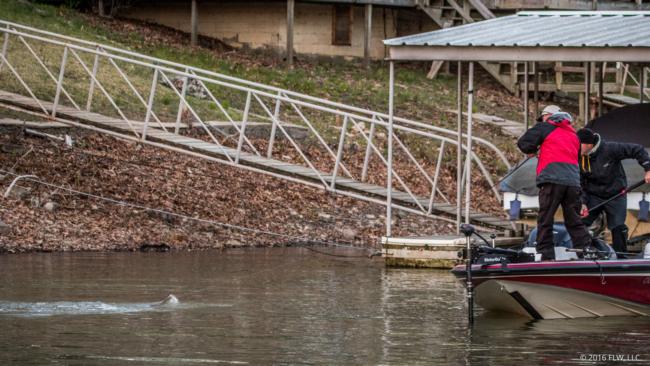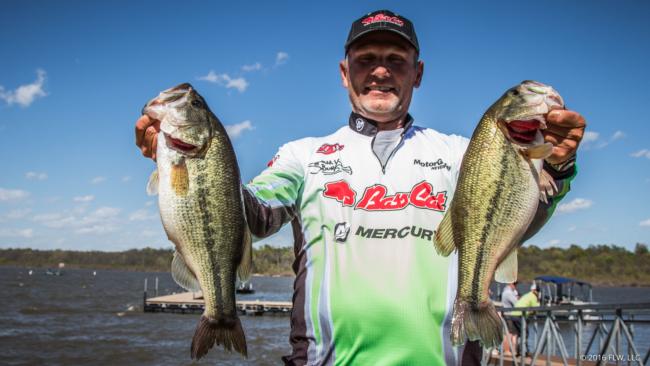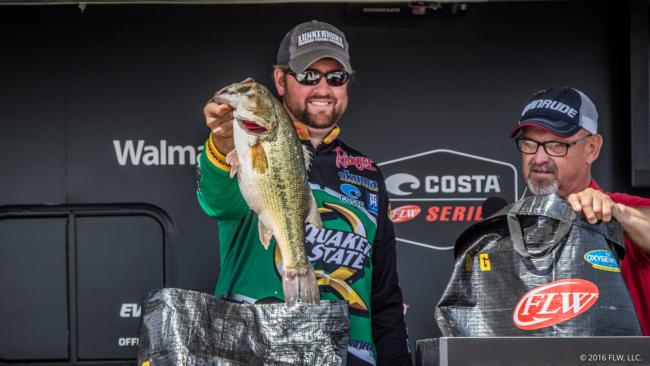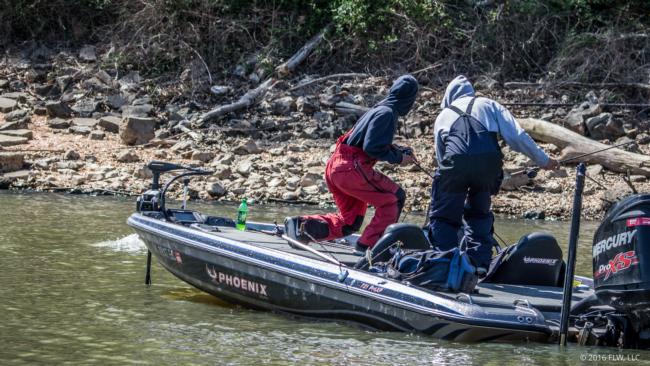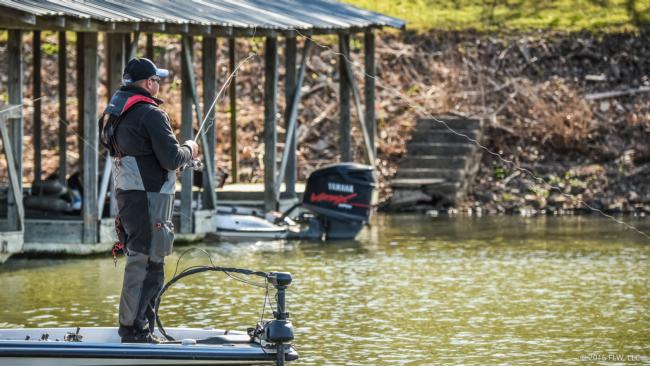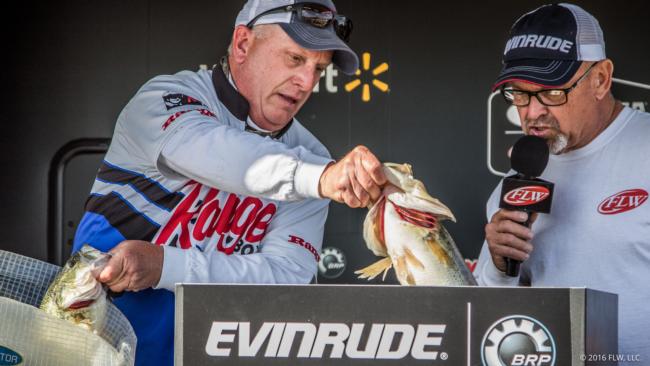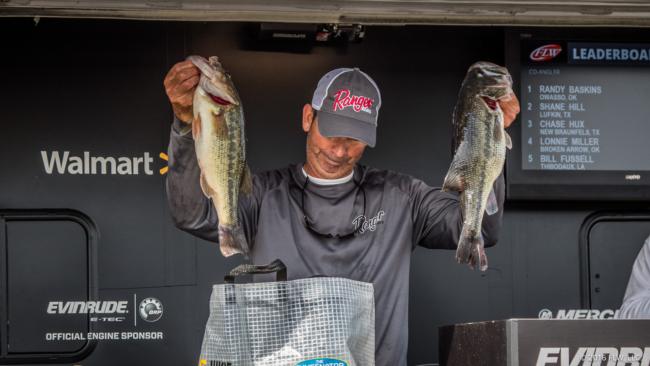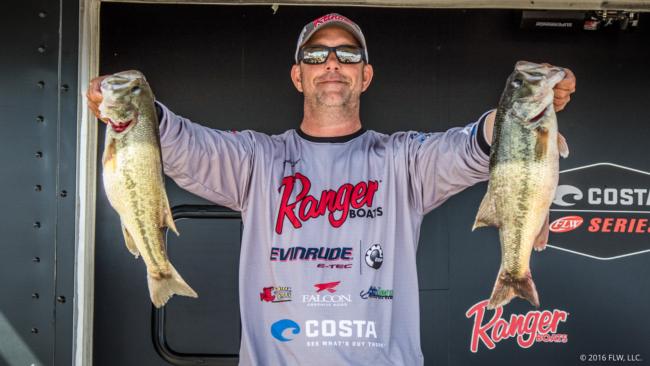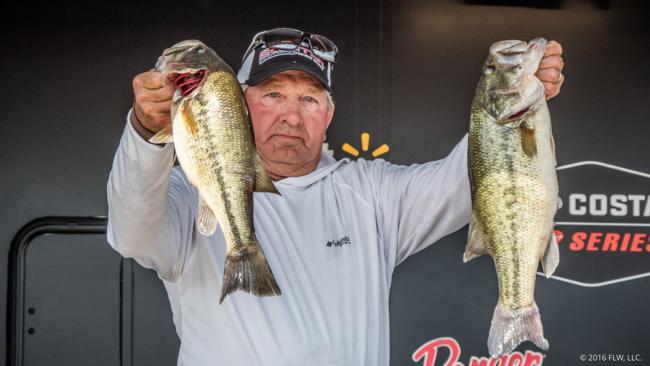Grand Lake Top 10 Patterns
How the top 10 caught their bass
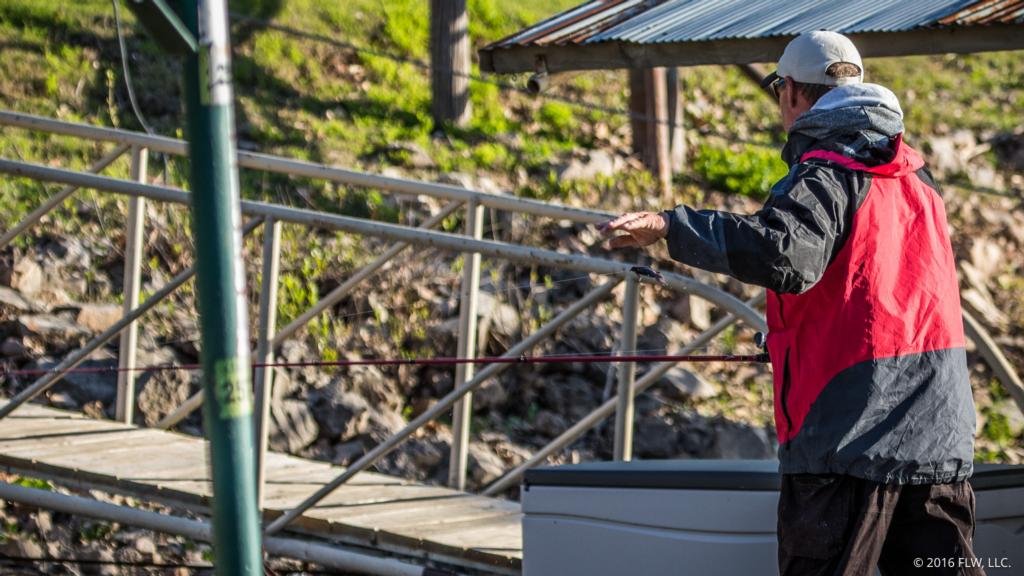
Zack Birge might have won the Costa FLW Series Southwestern Division event presented by Evinrude and hosted by the City of Grove on Grand Lake with a crankbait, but most of the top-10 spots were taken by anglers fishing jigs on rock banks leading into spawning pockets. There were some variations on that theme through the top of the field, but there is no doubt that a jig during the prespawn is still a force to reckoned with in the Ozarks.
2. Hartsell jigs docks for runner-up
Grand Lake was a heartbreaker for Toby Hartsell who weighed in four bass on the last day and missed winning the event by a pound and a half with a three-day total of 50-5.
Hartsell is considered by many to be an expert when it comes to fishing jigs around docks in the Ozarks. And he proved his dock-fishing savvy all week, targeting the areas behind big floating docks where few others bother to reach.
The problem when fishing around such objects, of course, is that some are going to get off, which is what cost Hartsell in the end.
To target areas behind the docks, Hartsell used two different jigs: a 3/8-ounce War Eagle Heavy Finesse jig and a 5/16-ounce Jewel Finesse Jig fished on 20-pound-test fluorocarbon line.
“I was not targeting certain kinds of docks, but rather the banks behind the docks,” Hartsell says. “The docks block off good transition banks where bass stage and spawn, and that’s where I was trying to get my jig into.”
3. Burks ran far for solitude and water color
When Sammy Burks started practice for the Costa FLW Series event on Grand, he kept finding dirty water and lots of fishing pressure. He decided to get away from it all by running far, far up the river, burning over a multitude of sandbars to reach secluded backwaters.
The result?
Catches of 18-7, 16-4 and 13-12 for a three-day total of 48-7 to finish third.
“I was burning through a foot of water to get to some of these places,” Burks says. “At times I could feel the boat catching on the bars because they were so shallow. Once I got back into the main creek channel, it dropped off to 7 feet, and the water was Grand Lake green – perfect for spinnerbaits and flipping.”
For his spinnerbait, Burks used a 1/2-ounce Bass Pro Shops model, which features a big No. 5 Colorado blade for a thumping vibration on 17-pound-test P-Line fluorocarbon. He also pitched bushes with a Reaction Innovations Sweet Beaver (black/blue) on a 1/2-ounce weight with 20-pound-test P-Line Ultimate Fluorocarbon.
4. Arey ‘blind bed-fishes’ for fourth
Matt Arey’s scorecard for the week included weights of 19-8, 14-3 and 14-8 for a total of 48-3 for the event.
Arey finished second in the Grand Lake FLW Series event last year. At that time Grand was exceptionally clear and fish were bedding everywhere. Arey vividly remembers exactly where the fish bedded on docks. He used those memories to his advantage this time around to “blind bed-fish” for spawning bass he could not see but knew were there.
“Last year it seemed like every back dock corner, walkway and cable had a bed on it,” Arey says. “So I just pitched to those kinds of targets over and over again. If one was there, it would swipe at it and knock slack in my line. I might not catch it on the first pitch, but if I kept pitching in there, I could usually catch it eventually.”
To blind bed-fish Arey used a 7/16-ounce homemade jig with a twin-tail trailer and a 4-inch Lunkerhunt Revealer Tube with a 5/16-ounce weight.
“When those fish bit, they would move so fast with the bait and knock so much slack in my line that I had to switch to an Okuma Helios TCS reel with an 8.1:1 gear ratio to catch up to them,” Arey says. “Once I went to a faster reel, I caught some of those that were previously running at me and spitting the bait before I could hook them.”
5. One lure for Warren
Chad Warren checked in weights of 17-8, 17-11 and 11-14, catching a total of 47-1 for three days. And all but one of his fish came on a single lure: a 3/8-ounce homemade round-head jig with a Zoom UV Speed Craw (green pumpkin) tied to 16-pound-test line.
Warren used his jig on gravel banks in and around docks.
“I could not see any fish because of the water color,” Warren says. “But I’m pretty sure they were spawning around those docks. They like to bed around those floating docks because the docks offer stability, knocking down the wave action and turbulence, giving them a calm place to spawn.”
6. Wolfe seeks reaction bite on creature baits
After sacking up weights of 19-13 and 19-7 the first two days, Jesse Wolfe led going into the last day. But he caught just 7-12 on the final day to fall to sixth with a total of 47-0.
Wolfe fished spawning cuts and pockets, too, but instead of dragging a jig he snapped and hopped a Reaction Innovations Sweet Beaver on a 3/16-ounce jighead with a spinning rod and 10-pound-test line for a reaction bite. He also caught some fish on a 3/8-ounce War Eagle Spinnerbait and pitching a 1/2-ounce Super K jig.
7. Tervin swims for seventh
Bill Tervin of Pocola, Okla., scored weights of 18-11, 15-12 and 10-4 over three days to finish seventh with 44-11. Tervin’s jig choice at Grand was a 1/2-ounce Buckeye Lures Flat Top Finesse Jig with a Strike King Rage Craw (green pumpkin purple) tied to 12-pound-test Vicious Fluorocarbon.
In addition to fishing a jig, Tervin also scored some quality weigh fish on a Reaction Innovations Little Dipper swimbait (sprayed grass), which is the technique Tervin used to win the Costa FLW Series event on Grand in 2014.
Tervin rigs the Little Dipper on a 1/8-ounce weight, 3/0 hook and 10-pound-test Vicious Fluorocarbon and slow-rolls it along the bottom, bumping rocks and small ledges.
“I keep the boat in about 8 feet of water and cast parallel to the bank and slow-roll it down through that 1- to 3-foot zone where the fish bed and stage up,” Tervin details. “I used a Halo casting rod for the technique and just reeled it very slowly, feeling for the rocks.”
8. Jig on rocks worked for Cooper
Matt Cooper did his part in keeping the jig theme alive and well on Grand Lake with daily weights of 16-8, 18-12 and 4-3, finishing eighth with a total of 39-7.
Cooper’s primary jig was a 5/16-ounce Jewel Finesse Jig (peanut butter and jelly) tipped with a green pumpkin Berkley Havoc Rocket Craw with the claw tips died orange. He fished the jig on 10-pound-test Seaguar InvizX fluorocarbon.
Cooper concentrated his jigging efforts on big rocks and outcroppings that formed points down the banks leading into spawning pockets.
“The first third going into a spawning cove was the most productive for me,” Cooper says. “Any rockslides or outcroppings that formed a deviation anywhere along the bank seemed to be better.”
9. Cecil cranks for ninth
This was Russell Cecil’s first trip to Grand Lake, and consequently he tried to put his own pattern together instead of mimicking the locals. He settled on shallow cranking as his main gig and used it to catch 19-14 on day one and 13-3 on day two, and then his pattern fizzled for a final-day catch of 3-15 for a three-day total of 37-0.
“I knew I couldn’t come here and compete with the local flipping experts who know exactly what banks and docks to fish,” Cecil says. “I was going to be at a serious disadvantage trying to beat these boys at their own game. So instead I tried to find something here that fit the way I like to fish: cranking flat points with a square-bill.”
Cecil’s crankbaits of choice included a 6th Sense Movement 80X and a 6th Sense Crush Flat 75X fished on 12-pound-test fluorocarbon.
“I was targeting flat points that had softball-size rock on them,” he says. “The key depth was to 2 to 5 feet. I mostly used the Flat Crush in that zone, and if I would see a shallow piece of wood up there on the point, I’d crank it with the Movement, which runs shallower.”
10. Hoskins rounds out top 10
Earl Hoskins checked in weights of 14-2, 19-0 and came up fishless on the last day to finish 10th with 33-2.
Hoskins relied on a 7/16-ounce Jewel Finesse Jig (green pumpkin) teamed with a Zoom UV Speed Craw with the pincers died orange, as well as an 8-inch lizard made by New Wave Soft Plastics and sold by Basskwondo. He fished the jig and the lizard on 25-pound-test Seaguar on JD rods.
Hoskin’s prime targets on Grand were chunk-rock banks, and he keyed in on the 8-foot zone for his bites.
